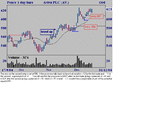barjon
Legendary member
- Messages
- 10,752
- Likes
- 1,863
afternoon all,
Last year my New Year's resolution was to try and improve my exit strategy since I felt I was leaving to much on the table and failing to get near the potential of the swing trades I had entered. My usual strategy up to then was to exit when the last swing low/high was breached. The attached chart of a trade I'm in at the moment shows the dilemma and how a trade with the proven potential of nearly +60 could finish up barely breaking even.
In pursuit of my resolution I have experimented this year with different strategies including fixed target exits; market action; trailing stops: various indicators etc but none seem to have proved wholly satisfactory.
Any thoughts?
Good trading
jon
ps: there's some commentary at the bottom of the chart in case you don't spot it first time 🙂
Last year my New Year's resolution was to try and improve my exit strategy since I felt I was leaving to much on the table and failing to get near the potential of the swing trades I had entered. My usual strategy up to then was to exit when the last swing low/high was breached. The attached chart of a trade I'm in at the moment shows the dilemma and how a trade with the proven potential of nearly +60 could finish up barely breaking even.
In pursuit of my resolution I have experimented this year with different strategies including fixed target exits; market action; trailing stops: various indicators etc but none seem to have proved wholly satisfactory.
Any thoughts?
Good trading
jon
ps: there's some commentary at the bottom of the chart in case you don't spot it first time 🙂

